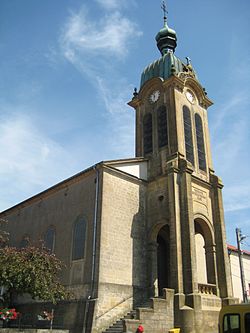Anoux | |
|---|---|
 The church in Anoux | |
| Coordinates: 49°16′34″N5°52′10″E / 49.2761°N 5.8694°E | |
| Country | France |
| Region | Grand Est |
| Department | Meurthe-et-Moselle |
| Arrondissement | Val-de-Briey |
| Canton | Pays de Briey |
| Government | |
| • Mayor (2020–2026) | André Berg [1] |
Area 1 | 9.88 km2 (3.81 sq mi) |
| Population (2022) [2] | 271 |
| • Density | 27/km2 (71/sq mi) |
| Time zone | UTC+01:00 (CET) |
| • Summer (DST) | UTC+02:00 (CEST) |
| INSEE/Postal code | 54018 /54150 |
| Elevation | 227–275 m (745–902 ft) (avg. 248 m or 814 ft) |
| 1 French Land Register data, which excludes lakes, ponds, glaciers > 1 km2 (0.386 sq mi or 247 acres) and river estuaries. | |
Anoux (French pronunciation: [anu] ) is a commune in the Meurthe-et-Moselle department in northeastern France.



